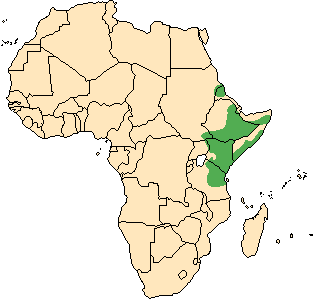![]() Return
to Artiodactyla
Return
to Artiodactyla
Classification
|
 Oryx
beisa
Oryx
beisa
Beisa oryx, East African oryx
![]()
Taxonomy
 |
 |
 |
Click on the pictures above for a larger view of the
photographs
|
||
General Characteristics
Body Length: 160-190 cm / 5.3-6.3 ft.
Shoulder Height: 110-120 cm / 3.6-4 ft.
Tail Length: 70-80 cm / 2.3-2.6 ft.
Weight: 150-200 kg / 330-440 lb.The grey-brown coat is separated from the white undersides by a thin black flank stripe. There are black bands above the "knees" of the front legs. The conspicuous black facial markings include a thick stripe running from the base of the horns, through the eye, to the lower cheek, a bell-shaped nose patch which does not usually touch the cheek stripes, and a patch on the forehead. There is a thin black dorsal stripe which runs into the black, tufted tail. The ears are long and narrow, and, in the browner fringe-eared oryx (O. b. callotis), have a tuft of black hairs at the tips. The horns are long, narrow, and virtually parallel, ridged on the lower half. Found in both sexes, they grow 75-120 cm / 2.5-4 feet long.
Ontogeny and Reproduction
Gestation Period: 8.5-10 months.
Young per Birth: 1
Weaning: After 3.5 months.
Sexual Maturity: Females at 1.5-2 years, males at 5 years.
Life span: Up to 18 years.Breeding occurs throughout the year, though synchronized calvings have been reported. After birth, calves lie up for 2-6 weeks, after which they join the herd.
Ecology and Behavior
The beisa oryx has a number of physiological adaptations which allow it to conserve water. Under conditions of extreme heat and low water, the oryx can raise its body temperature to 46.5o C (116o F). Up to this temperature, there is a normal flow of heat from the body to the environment without a loss of water. Only after this point does it start to perspire. Herds have a definite hierarchy, with a cow leading the herd and an 'alpha bull' bringing up the rear. However, if the lead cow strays off the set course, the bull hurries to the front to redirect the march. When threatened, beisa usually flee, although when cornered they present a spirited defense, sometimes inflicting fatal injuries with their spear-like horns.Family group: Mixed herds of 6-40 animals. Old bulls usually solitary.
Diet: Grasses, leaves, buds, fruit.
Main Predators: Lion, leopard, hyena, Cape hunting dog.
Distribution
Short grass steppes, semi-deserts and brush savannas in eastern Africa.

Range Map (Redrawn from IEA, 1998)
Conservation Status
The beisa oryx is classified as a low risk, conservation dependent species by the IUCN (1996).
Remarks
Considerable controversy exists regarding the taxonomy of the oryx tribe, with some authors lumping all four members of Oryx into a single species. Although the validity of O. dammah and O. leucoryx has been widely accepted, whether O. beisa should be considered a subspecies of O. gazella is still argued. However, due to their distinct ranges and characteristics, they are discussed here as separate species. Orux (Greek) a gazelle or antelope. Beisa is from beza (Amharic: an Ethiopian language from the Amhara district where this oryx lives).
Literature Cited
Allen, G. M. 1939. A Checklist of African Mammals.Bulletin of the Museum of Comparative Zoology (at Harvard College), Volume 83IEA (Institute of Applied Ecology). 1998. Oryx gazella. In African Mammals Databank - A Databank for the Conservation and Management of the African Mammals Vol 1 and 2. Bruxelles: European Commission Directorate. Available online at http://gorilla.bio.uniroma1.it/amd/amd211b.html
Kingdon, J. 1997. The Kingdon Field Guide to African Mammals. Academic Press, London and New York: NaturalWorld.
Walther, F. R. 1990. Roan and Sable Antelopes. In Grzimek's Encyclopedia of Mammals. Edited by S. P. Parker. New York: McGraw-Hill. Volume 5, pp. 437-447.
Return to Artiodactyla

![]()
© Brent Huffman, www.ultimateungulate.com |
|
|